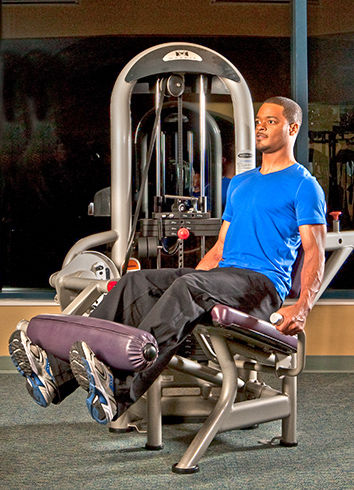
As a personal trainer, there is great satisfaction in helping people reach their goals. Recently, I’ve had the added satisfaction of helping two clients prevent or put-off knee surgery by strengthening the muscles related to knee movement and stabilization.
Knee pain can often be caused by muscular imbalances. This can cause the patella to go “off track,” being pulled laterally, due to the quadriceps’ lateral muscles being stronger than the medial ones. Strengthening the vastus medialis often pulls the patella back on track where it should be. The result of this is usually decreased pain and improved function.
“There is no question that the basis of conservative treatment for knee arthritis is a low-impact cardiovascular or weight-training program to build the knee’s surrounding muscle groups,” explains Mark Galland, M.D., an orthopedic surgeon specializing in sports medicine in Wake Forest, N.C., team physician for the Carolina Mudcats, and adjunct clinical professor at Marietta College. “The stronger and bigger the quadriceps and hamstring muscles are, and the more well-coordinated and flexible they are, the less severe the knee pain. The stronger those muscles are, the less likely you will need a knee replacement, and the less likely you will be to sustain a ligament or cartilage injury.”
And, as Galland points out, this is not just his opinion, but a fact backed up by research. “The American Academy of Orthopedic Surgeons issued a statement on the treatment of osteo-arthritic knee,” says Galland, “saying the two most important factors are maintenance of ideal body weight and regular performance of a low-impact, cardiovascular exercise regimen”
What Causes Muscular Imbalances?
“Some activities that we do repetitively can cause muscle imbalances,” explains Michele Olson, Ph.D., researcher and professor of exercise physiology at Auburn University Montgomery. “Runners, for example, usually have relatively weak hamstrings, because of how their pulling action works during the running gait. Most people have surprisingly weak gluteal muscles and arm and shoulder muscles. This often comes from over-working quads and chest muscles, because we tend to work the muscles we can see in the mirror.”

“There are many reasons for imbalances,” says Galland. “Genetics can play a role. Just like eye color or hair color, there are genetic factors that may predispose or actually cause muscular imbalances. Lifestyle can be a factor, where the way we go about [performing] certain tasks will favor a certain muscle group over another. Another cause could be personal preference in a workout routine. The client of a personal trainer may focus only on what can be seen in the mirror—because the back is not as visible, it does not receive the attention it should.”
Muscle imbalances can also occur between each side of the body, particularly in the arms and shoulders. I’ve had several clients with noticeable discrepancies in arm and shoulder strength. And it doesn’t always equate to dominant side versus non-dominant. In this case, we train each arm separately, doing a little extra work on the weaker side, trying to catch it up to the stronger one.
The core is another common area for muscle imbalances, in particular, between the inner and outer core units. The inner unit is comprised of the core’s deeper, stabilizing muscles, including the transverse abdominis. The superficial, spine-moving muscles, including the rectus abdominis, make up the outer unit. The inner unit is often weaker due to neglect, because common exercises, such as crunches, work the outer unit. The outer unit can then compensate for the inner unit, so it is imperative that you include isometric exercises that target the inner unit, such as the plank. The “holding” isometric exercises focus on this area, because the inner unit supports and stabilizes the spine, essentially holding it erect.
Olson explains that trainers can do a couple of simple tests to determine if there are imbalances in the lower- or upper-body muscles.
“Simply test and compare quad and hamstring strength on weight machines,” she says. “Hamstrings should be at least 60 percent as strong as the quads. You should also be able to perform biceps curls and overhead presses that are at least 25 percent of your total body weight.”
How to Help Your Clients Restore Muscular Balance
Chances are, you’ve got a client with muscle imbalances, because this is a very common condition. In fact, 33 percent of the population reports having knee pain, and the incidence of back pain is even higher. The ACE Orthopedic Exercise Specialty Certification was created specifically to educate fitness professionals on how to design exercise programs that incorporate appropriate progressions and strategies to improve movement, avoid injury and boost function. Trainers who earn this certification are able to market their skills to physicians and their patients who have gone through physical therapy for post-rehab training—and be able to do so with confidence and the knowledge they can take them to the next level beyond rehab.
This certification also covers how to test for muscle imbalances, deficits in balance and proprioception, and loss of range of motion. A course on post-rehab training is included, as well as in-depth courses for preventing injury and ending pain in the knees, shoulders and lower back.
This invaluable course will not only increase a trainer’s marketability, but will also give them the necessary tools to help clients who may think they need to take a break from training due to injury or pain. This increases their credibility, as well as their bottom line.





 by
by 



